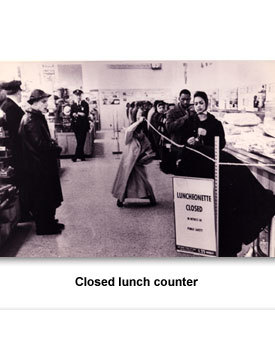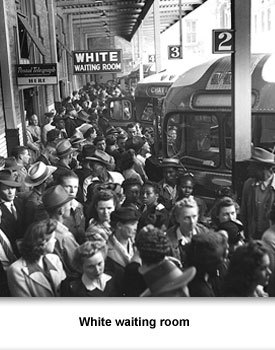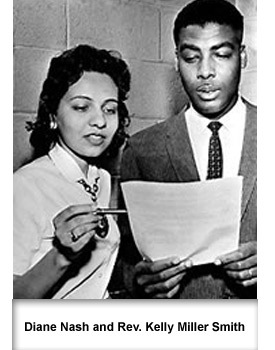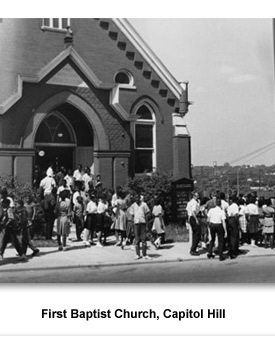Civil Rights / Cold War
Why Sit-Ins?
After holding the non-violence workshops, the Nashville Christian Leadership Council (NCLC) and the Nashville college students needed a cause. There was plenty of discrimination in everyday life. The question was where to start?
Jim Lawson had visited local church and business groups asking about which form of segregation they wanted changed the most. Black women were almost unanimous in saying discrimination at downtown department and five and dime stores.
At this time, most people shopped for clothes and other home items in the downtown area. African American women shopped beside white women and bought the same things. But they could not try on the clothing. They could not use the white only restrooms. And most insulting, if they or their children were hungry, they could not sit down and eat in the stores’ lunchrooms or restaurants.
The NCLC decided to push for desegregation of lunchroom counters using sit-in tactics. Protesters, the Nashville college students, would go in the store and sit down at the counter. If denied service or asked to leave, the students would just continue sitting in the chair. In this way they were putting pressure on the business to change their policy since no one could be served as long as they were sitting in the seats. Dig Deeper: Who were some of the Nashville students?
They recruited more students to help. Besides the people actually doing the sitting, they needed drivers to bring the students downtown from the college campuses. They needed protest signs painted; food prepared; and, in this time when people didn’t have cell phones, people to carry messages back and forth from the protesters to the coordinators.
Kelly Miller Smith offered First Baptist Church in downtown Nashville at Charlotte and 8th Avenue as the meeting area. Classes on non-violence protest continued at the church. If the protesters were arrested, the group wanted others to slip in behind them and take the seats. The idea was to overwhelm the jails. American Baptist student John Lewis and others developed instructions for the demonstrators to use. Read John Lewis’ instructions to people who were sitting in.
The Nashville students even did two practice sit-ins to determine how the business owners would react. In both cases, the students got up and left when they were refused service. But before they could do the actual sit-in, four students in Greensboro, North Carolina, did the first sit-in on February 1, 1960. The students hadn’t prepared, hadn’t practiced, but just went into a Woolworth’s store and sat at the lunch counter.
Picture Credits:
- Photograph taken in 1960 of Diane Nash and Rev. Kelly Miller Smith. Nash was one of the student leaders of the sit-ins while Rev. Smith allowed the students and James Lawson to use his church, First Baptist Church, for non-violence training classes. Courtesy of The Tennessean
- Photograph of Kelly Miller Smith’s First Baptist Church, Capitol Hill—the staging point for the Nashville Sit-ins. Nashville Public Library, Special Collections Division, Nashville Banner Archives
- Pop-up photograph of John Lewis, Tennessee State Museum Colleciton, 2008.336.4
- Tennessee A&I students Lucretia Collins and Benny Grant sit at a lunch counter after the management has closed the counter "in interest of public safety." The photograph is dated March 4, 1960. Photo by Eldred Reaney, Courtesy of The Tennessean
- A photograph of people waiting at the Memphis bus station in 1943. Notice the sign above "White Waiting Room." Photograph by Esther Bubley, Library of Congress
Civil Rights / Cold War >> Civil Rights Movement >> Nashville Sit-Ins >> Why Sit-Ins?




 Sponsored by: National Endowment for the Humanities
Sponsored by: National Endowment for the Humanities